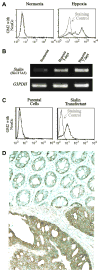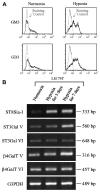Altered sphingolipid metabolism induced by tumor hypoxia - new vistas in glycolipid tumor markers
- PMID: 19913543
- PMCID: PMC2856702
- DOI: 10.1016/j.febslet.2009.11.019
Altered sphingolipid metabolism induced by tumor hypoxia - new vistas in glycolipid tumor markers
Abstract
Uncontrolled growth of malignant cells produces hypoxic regions in locally advanced tumors. Recently we showed that tumor hypoxia-induced transcription of multiple genes involved in glycan synthesis, leading to expression of useful glycolipid tumor markers, such as gangliosides having N-glycolyl sialic acid. Our subsequent studies indicated that the ceramide portion of glycolipids, as well as their glycan moiety, was also significantly affected by hypoxia. Tumor hypoxia-induced marked accumulation of sphinganine (dihydrosphingosine) long-chain base, and significant reduction of unsaturated very long-chain fatty acids in the ceramide moiety. Mass-spectrometry, which yields information on both glycan- and ceramide moieties, is expected to be clinically useful in detecting such distinct molecular species of cancer-associated glycolipids having combined alteration in both glycan- and ceramide moieties.
Copyright 2009 Federation of European Biochemical Societies. Published by Elsevier B.V. All rights reserved.
Figures




Similar articles
-
Disruption of sphingolipid metabolism augments ceramide-induced autophagy in preeclampsia.Autophagy. 2015 Apr 3;11(4):653-69. doi: 10.1080/15548627.2015.1034414. Autophagy. 2015. PMID: 25853898 Free PMC article.
-
Altered expression of glycan genes in cancers induced by epigenetic silencing and tumor hypoxia: clues in the ongoing search for new tumor markers.Cancer Sci. 2010 Mar;101(3):586-93. doi: 10.1111/j.1349-7006.2009.01455.x. Epub 2009 Dec 4. Cancer Sci. 2010. PMID: 20085584 Free PMC article. Review.
-
Sphingolipids in inflammatory hypoxia.Biol Chem. 2018 Sep 25;399(10):1169-1174. doi: 10.1515/hsz-2018-0173. Biol Chem. 2018. PMID: 29908122 Review.
-
A mass spectrometry-based method for the assay of ceramide synthase substrate specificity.Anal Biochem. 2015 Jun 1;478:96-101. doi: 10.1016/j.ab.2015.02.016. Epub 2015 Feb 26. Anal Biochem. 2015. PMID: 25725359
-
Sphingolipids and cancer: ceramide and sphingosine-1-phosphate in the regulation of cell death and drug resistance.Future Oncol. 2010 Oct;6(10):1603-24. doi: 10.2217/fon.10.116. Future Oncol. 2010. PMID: 21062159 Free PMC article. Review.
Cited by
-
Metabolic Reprogramming of Ovarian Cancer Spheroids during Adhesion.Cancers (Basel). 2022 Mar 9;14(6):1399. doi: 10.3390/cancers14061399. Cancers (Basel). 2022. PMID: 35326551 Free PMC article.
-
Preclinical Evaluation of a Near-Infrared Labelled Antibody Targeting the Tumour Associated Xenoantigen N-Glycolyl-Neuraminic Acid GM3 Ganglioside.Mol Imaging Biol. 2025 Aug;27(4):518-528. doi: 10.1007/s11307-025-02026-z. Epub 2025 Jun 17. Mol Imaging Biol. 2025. PMID: 40526182 Free PMC article.
-
Global profiling of metabolic adaptation to hypoxic stress in human glioblastoma cells.PLoS One. 2015 Jan 29;10(1):e0116740. doi: 10.1371/journal.pone.0116740. eCollection 2015. PLoS One. 2015. PMID: 25633823 Free PMC article.
-
Comprehensive Profiling of Surface Gangliosides Extracted from Various Cell Lines by LC-MS/MS.Cells. 2019 Oct 26;8(11):1323. doi: 10.3390/cells8111323. Cells. 2019. PMID: 31717732 Free PMC article.
-
Molecular recognition of gangliosides and their potential for cancer immunotherapies.Front Immunol. 2014 Jul 21;5:325. doi: 10.3389/fimmu.2014.00325. eCollection 2014. Front Immunol. 2014. PMID: 25101077 Free PMC article. Review.
References
-
- Hakomori S. Tumor-associated carbohydrate antigens defining tumor malignancy: basis for development of anti-cancer vaccines. Adv Exp Med Biol. 2001;491:369–402. - PubMed
-
- Sabbatini PJ, Ragupathi G, Hood C, Aghajanian CA, Juretzka M, Iasonos A, Hensley ML, Spassova MK, Ouerfelli O, Spriggs DR, Tew WP, Konner J, Clausen H, Abu RN, Dansihefsky SJ, Livingston PO. Pilot study of a heptavalent vaccine-keyhole limpet hemocyanin conjugate plus QS21 in patients with epithelial ovarian, fallopian tube, or peritoneal cancer. Clin Cancer Res. 2007;13:4170–4177. - PubMed
-
- Koike T, Kimura N, Miyazaki K, Yabuta T, Kumamoto K, Takenoshita S, Chen J, Kobayashi M, Hosokawa M, Taniguchi A, Kojima T, Ishida N, Kawakita M, Yamamoto H, Takematsu H, Kozutsumi Y, Suzuki A, Kannagi R. Hypoxia induces adhesion molecules on cancer cells-a missing link between Warburg effect and induction of selectin ligand carbohydrates. Proc Natl Acad Sci U S A. 2004;101:8132–8137. - PMC - PubMed
Publication types
MeSH terms
Substances
Grants and funding
LinkOut - more resources
Full Text Sources
Other Literature Sources
Medical

